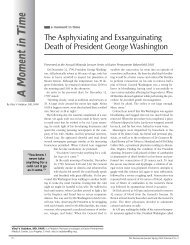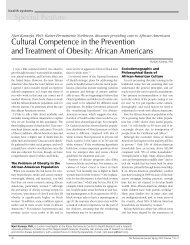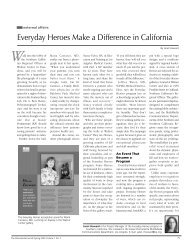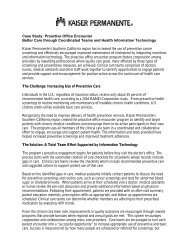Bereavement Newsletter 4 - Kaiser Permanente
Bereavement Newsletter 4 - Kaiser Permanente
Bereavement Newsletter 4 - Kaiser Permanente
You also want an ePaper? Increase the reach of your titles
YUMPU automatically turns print PDFs into web optimized ePapers that Google loves.
GRIEF EDUCATION AND SUPPORT MAILING PROGRAM<br />
This newsletter is being provided<br />
by the <strong>Bereavement</strong> Department of<br />
The <strong>Kaiser</strong> Hospice Program<br />
10992 San Diego Mission Rd., 3 rd floor<br />
San Diego, CA 92108<br />
(619) 641-4100<br />
Fourth in a Series of Five <strong>Newsletter</strong>s<br />
___________________________________________________________________________________________________________<br />
About This<br />
<strong>Newsletter</strong>...<br />
Many highly respected writers<br />
have addressed the subject of<br />
bereavement and the stages of<br />
grief. The stages have different<br />
names depending on the author but,<br />
in general, they are<br />
1. Numbness/shock<br />
2. Feeling the pain<br />
3. Saying good-bye<br />
4. Reinvesting in life/others<br />
People go through these stages<br />
differently. You can sometimes be<br />
in one stage and then in another.<br />
You can be in two stages at the<br />
same time. In other words, it is not<br />
necessarily an orderly process and<br />
it is not something you do once and<br />
“graduate.”<br />
We all need help and<br />
encouragement at times. Human<br />
experience tells us that if we wait<br />
until we feel better before we make<br />
changes, we may wait a long time.<br />
There is an article in this issue<br />
entitled, “Are You At An<br />
Impasse?” Please read it carefully.<br />
Continued on page 2<br />
The Four phases of Mourning<br />
“Letting Go”<br />
Resuming your own life after<br />
losing a loved one is a difficult and<br />
emotional task. The path does not<br />
seem clear; and “traveling” alone<br />
does not feel safe. Yet grief and<br />
mourning (the expression of this<br />
grief) allows you to heal, and helps<br />
you to cross the bridge that leads to<br />
your reinvestment in other people<br />
and other things.<br />
This newsletter is intended to<br />
address the topic of “letting go”<br />
which describes the slow process of<br />
relinquishing some of the painful<br />
associations to your loved one, and<br />
moving forward to see what life<br />
may still have to offer you.<br />
You have already begun the<br />
“letting go” process when you<br />
recognize that you have withstood<br />
a tremendous loss and that all the<br />
feelings connected to this loss are<br />
real. The tears, the anguish, the<br />
anger, and the guilt all signify a<br />
normal mourning process.<br />
Repeated expressions of these<br />
feelings connected to this loss are<br />
real. Repeated expressions of these<br />
In This Issue<br />
“Letting Go”<br />
feelings (just when you thought<br />
you were through) may be<br />
necessary before you are truly<br />
ready to master the loss and find a<br />
healthy restitution.<br />
Permit yourself extra time to ask<br />
the “unanswerable whys” just one<br />
more time before letting go --<br />
before accepting. Also, seek<br />
somebody else out to share this<br />
with; a friend, a professional, or a<br />
family member. True acceptance<br />
and “letting go” only occurs when<br />
you reach out and form a bond with<br />
somebody else. You may wish to<br />
renew an old relationship; or<br />
establish a new friendship through<br />
a social group at this time.<br />
Whatever you do, as you reestablish<br />
a human connection, you<br />
will begin to feel healing take place<br />
inside. You may discover some of<br />
the meaning returning to your life<br />
as you reach out.<br />
“Letting go” not only involves<br />
validating your feelings, and<br />
reaching out; but also leaving<br />
behind some of your old self.<br />
Continued on page 2<br />
<strong>Kaiser</strong> <strong>Permanente</strong> <strong>Bereavement</strong> Support<br />
Groups<br />
Are You at an Impasse?<br />
The Elephant in the Room<br />
About This <strong>Newsletter</strong>... Yet we squeeze by with, “How are “Letting Go”
Continued from page 1<br />
This is a good time to reflect on<br />
your grief process, thus far, and ask<br />
yourself how you are doing. There<br />
is a response sheet attached which<br />
you may complete and return, if<br />
you are having difficulty and would<br />
like a staff person to phone you.<br />
Also, our bereavement support<br />
groups can provide assistance and<br />
encouragement as you make<br />
decisions and changes. We invite<br />
you to attend our groups, if you are<br />
not already doing so. Remember,<br />
be patient with yourself and treat<br />
yourself good.<br />
Pat Myers, LCSW<br />
<strong>Bereavement</strong> Coordinator<br />
The Elephant<br />
in the Room<br />
There’s an elephant in the room.<br />
It is large and squatting, so it is<br />
hard to get around it.<br />
you?” and, “I’m fine”...<br />
And a thousand other forms of<br />
trivial chatter.<br />
We talk about the weather.<br />
We talk about work.<br />
We talk about everything else --<br />
except the elephant in the room.<br />
There’s an elephant in the room.<br />
We all know it is there.<br />
We are thinking about the elephant<br />
as we talk together.<br />
It is constantly in our minds.<br />
For, you see, it is a very big<br />
elephant.<br />
It has hurt us all.<br />
But we do not talk about the<br />
elephant in the room.<br />
Oh please, say her name.<br />
Oh please, say “Barbara” again.<br />
Oh please, let’s talk about the<br />
elephant in the room.<br />
For if we talk about her death,<br />
perhaps we can talk about her life?<br />
Can I say “Barbara” to you and<br />
not have you look away?<br />
For if I cannot, then you are<br />
leaving me --<br />
Alone...<br />
In a room...<br />
With an elephant.<br />
By Terry Kettering<br />
Continued from page 1<br />
Because of your loved one’s loss,<br />
you may never be the same again.<br />
However, the opportunity to create<br />
a new you exists. Grief has a<br />
unique way of enabling you to<br />
develop and grow through the pain.<br />
Take advantage of this time to<br />
rebuild and welcome the chance to<br />
create.<br />
This may mean making new<br />
friends, making a move, taking a<br />
new job, learning a new skill, or<br />
getting a new wardrobe. Whatever<br />
the<br />
change is for you, developing this<br />
new self after a period of mourning<br />
may bring welcome feelings of<br />
happiness.<br />
____________________________<br />
“Letting go” not only involves<br />
validating your feelings and<br />
reaching out; but also leaving<br />
behind some of your old self.<br />
____________________________<br />
“Letting go” is a turning point<br />
for those who have been grieving<br />
for their loved one. It does not<br />
mean that you forget about your<br />
loved one or block out the<br />
memories of your life together. It<br />
simply means that it is time to<br />
review the tasks of living, having<br />
integrated the loss as part of who<br />
you are, and moving on as a<br />
stronger human being. There need<br />
not be any guilt or remorse in this<br />
action, as your loved one wishes<br />
for your health and happiness.<br />
“Letting go” signifies a new<br />
beginning.<br />
Shellie Hatfield, L.C.S.W.<br />
____________________________________Fourth in a series of Five <strong>Newsletter</strong>s_________________________________ 2
Important Words<br />
From a Survivor<br />
“I am grieving now. I need to be grateful that I can grieve, but that doesn’t make it any<br />
less painful. I hate grieving, and I hate the anger I feel, too. I wish it would all go away<br />
and I could keep up my normal schedule like a normal person.”<br />
“But I am a normal person. Any normal person who saw what I saw and suffered the<br />
losses I have suffered would be grieving too I’ve worked hard to get in touch with my<br />
feelings, and this sadness is one of them.<br />
“Just think, I used to go numb, overeat, space out, and drink instead of feeling this grief.<br />
I can now see why I wanted to escape it. The pain is so bad, and I don’t know when it<br />
will end. I feel trapped by it, like there’s no way out.<br />
“But I’ve made progress. I can face it all without running away. I must be very strong<br />
to be able to tolerate all this suffering without trying to escape. I need to congratulate<br />
myself instead of putting myself down.<br />
Also, I need to stop thinking of this grieving as a sign of my emotional weakness or<br />
mental instability. I need to remember that my grief is a mirror of my love for the people<br />
I have lost. They are worth my tears. My grief gives dignity to their death. It’s okay if I<br />
grieve for them over and over again. They are worth it.”<br />
From “I Can’t Get Over It: A Handbook for Trauma Survivors’<br />
____________________________________Fourth in a series of Five <strong>Newsletter</strong>s_________________________________ 3
O<br />
Timetables For Grief<br />
ne of the most frequently asked questions is: “How long will these feelings last?”<br />
The following guidelines are general descriptions and may vary widely from one<br />
individual to another.<br />
Month one: In the first month, grieving persons may be so busy with funeral arrangements,<br />
visitors, paperwork and other immediate tasks that they have little time to begin the grieving<br />
process. They may also be numb and feel that the loss is unreal. This shock can last beyond<br />
the first month if the death was sudden, violent or particularly untimely.<br />
Month three: The three month point is a particularly challenging time for many grieving<br />
persons. Visitors have gone home, cards and calls have pretty much stopped coming in, and<br />
most of the numbness has worn off. Well meaning family and friends who do not understand<br />
the grief process may pressure the grieving person to get back to normal. The grieving person<br />
is just beginning the very painful task of understanding what this loss really means.<br />
Months four through twelve: The grieving person continues to work through the many<br />
tasks of learning to live with the loss. There begins to be more good days than bad days.<br />
Difficult periods will crop up sometimes with no obvious trigger, even late into the last half of<br />
the first year. It is important that the grieving person understands that these difficult periods<br />
are normal, rather than a set back or a sign of lack of progress.<br />
Significant anniversaries: During the first year, personal and public holidays present<br />
additional challenges. Birthdays (of the deceased and other family members), wedding<br />
anniversaries, and family and school reunions can be difficult periods. Medical anniversaries,<br />
such as the day of the diagnosis, the day someone was hospitalized or came home from the<br />
hospital can also bring up memories. The grieving person may not be consciously keeping<br />
track of these dates, but is still affected by them.<br />
The one-year anniversary of the death: Reactions to the anniversary of the death may<br />
begin days or weeks before the actual date. Many people describe reliving those last difficult<br />
days. Even individuals who have been doing very well toward the end of the first year may be<br />
surprised at how intensely the one-year anniversary affects them. People generally welcome<br />
additional acknowledgment or support during anniversaries.<br />
The second year: Most grieving people agree that it takes at least two years to start feeling<br />
like they have established workable new routines and a new identity without the deceased<br />
person. Many of the tasks of the second year have to do with re-assessing goals, discovering<br />
a new identity and creating a different life style.<br />
Taken from “Timetables for Grief”<br />
a handout developed by Kansas City Hospice,<br />
underwritten by Prime Health Foundation.<br />
____________________________________Fourth in a series of Five <strong>Newsletter</strong>s_________________________________ 4
Ten Suggestions to<br />
Help Overcome Grief<br />
Take time to accept death - Facing and accepting death remains a necessary condition for continuing our<br />
own life.<br />
Take time to let go -- Letting go means adjusting to a new reality in which the deceased is no longer<br />
present. Letting go occurs when we are able to accept whatever feelings -- anger, guilt, fear, sadness --<br />
accompany death. Letting go occurs when we are able to tolerate the feelings, to wait, trust and hope<br />
again.<br />
Take time to make decisions -- It is important that the bereaved be patient with themselves and gradually<br />
make decisions as a way to control and sustain self worth. But it is wise to postpone major decisions.<br />
Take time to share -- The greatest need of the bereaved is to have someone share their pain, their<br />
memories, their sadness.<br />
Take time to believe -- For many people, religion offers a comforting and strengthening base in the<br />
lonely encounter with helplessness and hopelessness.<br />
Take time to forgive -- We need to accept our imperfections, not torture ourselves for the things we did or<br />
did not do.<br />
Take time to feel good about yourself -- Exploring new interests, developing hobbies, and taking<br />
advantage of new opportunities are all activities designed to help the bereaved reinvest their energies in<br />
new endeavors.<br />
Take time to meet new friends -- Healing occurs when we move out of our safe boundaries and interact<br />
with others. New friends will be there to offer opportunities. Join a support group, a club, or take a<br />
class.<br />
Take time to laugh -- Laughter helps us survive and re-enter life.<br />
Take time to give -- The best way to overcome loneliness and grief is to be concerned about the pain of<br />
others. If we find someone who needs us, that will be our opportunity for healing. Get involved with<br />
others.<br />
____________________________________Fourth in a series of Five <strong>Newsletter</strong>s_________________________________ 5
ARE YOU AT AN IMPASSE?<br />
How to Tell if You Are “Stuck”<br />
Sometimes it may be difficult for you to decide if you are progressing normally or if it may be time to<br />
get some additional help. The following is a list of warning signs that you may be floundering, stuck, or<br />
experiencing a complicated reaction:<br />
You feel immobilized and have not been able to make any progress towards healing for a period<br />
of time.<br />
You feel helpless and the prospect of living a full life seems remote.<br />
You still talk about your loved one in the present tense or act as though he/she were still living.<br />
You are still unable to talk about your loved one without experiencing intense and fresh grief. In<br />
other words, your grief is still as intense as it was just after the death.<br />
You find yourself preoccupied with thoughts of your loved one and recognize consistent themes<br />
of loss, death and grief in your conversation with others.<br />
You continue to feel no interest or joy in other people, things, your job, or your life and you<br />
resent those who are happy or content.<br />
You are actively considering suicide, have a suicide plan, or find yourself engaged in selfdestructive<br />
behavior. Beware of more passive self-destruction that involves simply letting<br />
yourself go, ignoring physical symptoms, and behaving recklessly.<br />
Your addictive behaviors have increased or you find yourself using drugs, alcohol, cigarettes,<br />
food, or gambling to cope with your pain. You use your grief to justify destructive coping<br />
strategies.<br />
You repeatedly behave in ways that bring about unnecessary losses. For example, you set<br />
yourself up for rejection by acting in ways that alienate others.<br />
Your anger is so intense that it is spoiling your relationships.<br />
Your behavior has changed dramatically and in ways that are not good for you. Perhaps you are<br />
inappropriately or indirectly acting out your feelings of grief. Do you find yourself having<br />
accidents, entering into foolish social and economic situations, engaging in unhealthy<br />
relationships, altering your good relationships, or radically and impulsively changing your<br />
lifestyle?<br />
If any of these things sound familiar to you or, if you are concerned about your present situation, it may<br />
be useful to consider getting professional assistance. Although you may feel overwhelmed at this time,<br />
don’t panic! Help is available, and we are committed to assisting you in locating the resources you need<br />
to move forward in the healing process.<br />
Source: San Diego Hospice<br />
<strong>Bereavement</strong> Department <strong>Newsletter</strong><br />
“Living With Loss”<br />
____________________________________Fourth in a series of Five <strong>Newsletter</strong>s_________________________________ 6
KAISER PERMANENTE HOSPICE<br />
Grief Education and Support Mailing Program<br />
IF YOU ARE EXPERIENCING DIFFICULTIES IN THE GRIEF PROCESS<br />
YOU MAY CONTACT THE<br />
KAISER HOSPICE BEREAVEMENT DEPARTMENT<br />
AT (619) 641-4636<br />
“You cannot prevent<br />
the birds of sorrow<br />
from flying over your<br />
head, but you can prevent<br />
them from building nests<br />
in your hair.”<br />
--Chinese Proverb<br />
____________________________________Fourth in a series of Five <strong>Newsletter</strong>s_______________________________ 7
____________________________________Fourth in a series of Five <strong>Newsletter</strong>s_______________________________ 8

















